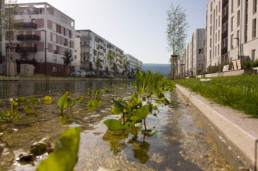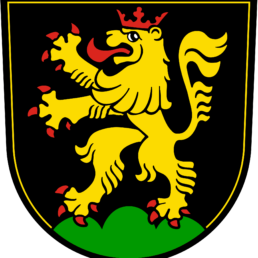Passive house standards, rooftop vegetation, and non-motorized transportation will make Bahnstadt the largest zero-emissions city district in the world.
In Heidelberg, the new district Bahnstadt is the largest urban development project in Germany, and, at 116 hectares, boasts the largest area covered by passive houses in the world. The houses’ ultra-low energy consumption is far lower than required under the country’s building energy efficiency standards. A large woodchip-powered combined heat and power plant was constructed specifically for the district that provides Bahnstadt with 24 million kWh of electricity and 80 million kWh of heating energy annually, enough to cover the entire district’s energy demand and to reduce CO2 emissions to almost 0%. The wood chips are collected from sustainable sources, such as landscape maintenance waste.

Due to Bahnstadt’s central location in Heidelberg, with quick access to the city’s main railway station, trams, and buses, motorized transport is minimized. When residents do need a car, a car-sharing fleet of electric vehicles is readily available – and planned to be expanded to 1,800 EVs by 2020. Attractive walking and cycle paths in and outside the district have made the bicycle the main mode of transport in Bahnstadt, contributing to Heidelberg’s goal of reducing greenhouse gas emission by 95% by 2050.
30,000 tonnes of CO2 reduced each year from the wood chip-powered combined heat and power plant
The challenge
When a former freight and switch yard was shuttered in Heidelberg, a central city district became a desolate brownfield. With scarce living space in the city center, Heidelberg initiated an urban redevelopment project, Bahnstadt. Built to accommodate the city’s ambition of dramatically lowering its CO2 emissions, the project proves the case for zero-emissions city districts.
Co-benefits
Economic The development of the Bahnstadt district has created 7,000 jobs, lowering the unemployment rate and contributing to economic development.
Environmental All households in the district are equipped with smart meters, so residentscan keep track of their energy consumption and costs, encouraging low energy use.
Health By providing attractive infrastructure for cyclists, bike parking facilities and other bicycle-related services, the city encourages Bahnstadt’s residents to bike, improving residents’ health.
Social The district offers accessible flats for handicapped and elderly residents, large flats for families, small flats for students, and a funding program which provides low-income residents with up to one-third of the monthly rent.
About Heidelberg
Heidelberg is a college town in Baden-Württemberg situated on the river Neckar in south-west Germany. At the 2015 census, its population was 156,257, with roughly a quarter of its population being students. A scientific hub in Germany, the city of Heidelberg is home to several internationally renowned research facilities adjacent to its university, including four Max Planck Institutes. A former residence of the Electorate of the Palatinate, Heidelberg is a popular tourist destination due to its romantic cityscape, including Heidelberg Castle, the Philosophers’ Walk, and the baroque style Old Town.


